
Mastering Precision: The Indispensable Role of Determiners Worksheets in Language Learning
English, a language of vast vocabulary and intricate grammatical structures, often presents challenges even to native speakers, let alone those learning it as a second language. Among the myriad components that contribute to its precision and clarity, determiners stand out as unsung heroes. These small but mighty words precede nouns, providing crucial information about their identity, quantity, or possession. While their function might seem straightforward, mastering their correct usage is vital for clear communication and grammatical accuracy. This is where determiners worksheets become an indispensable tool in the language learning journey.
What Exactly Are Determiners?

Before delving into the benefits of determiners worksheets, let’s clarify what determiners are. A determiner is a word or a group of words that introduces a noun. Its primary role is to specify, quantify, or identify the noun it precedes. Unlike adjectives, which describe nouns, determiners limit or specify them. They answer questions like "which one?", "how many?", or "whose?".
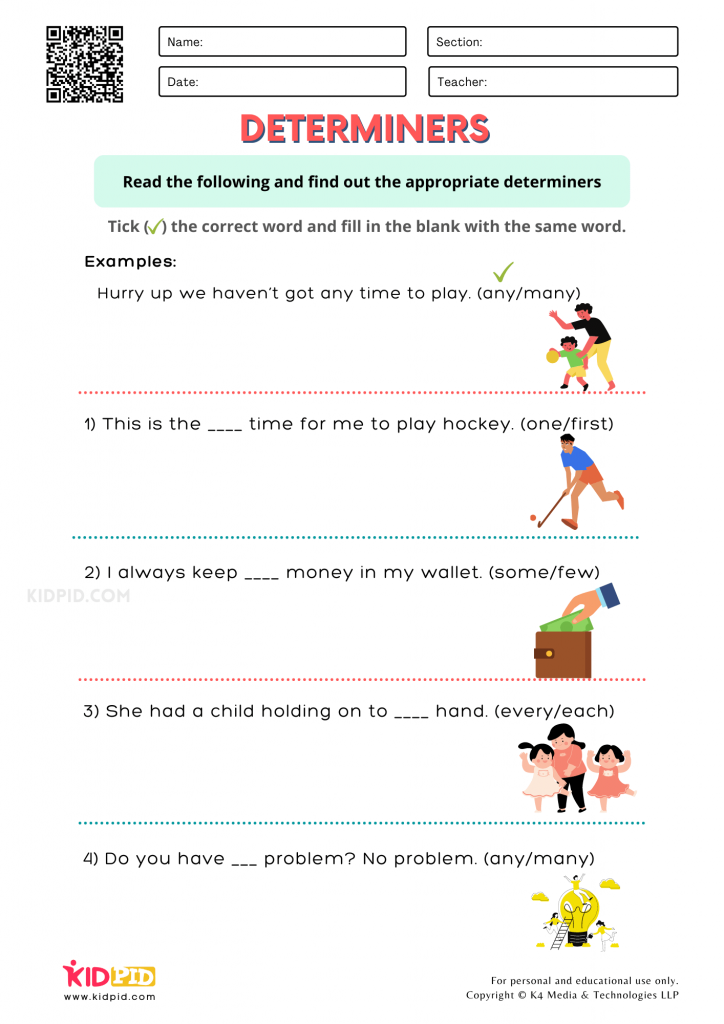
Consider the difference:

- "I saw a dog." (A general, unspecified dog)
- "I saw the dog." (A specific dog, known to both speaker and listener)
- "I saw my dog." (A specific dog belonging to the speaker)
- "I saw many dogs." (A specific quantity of dogs)

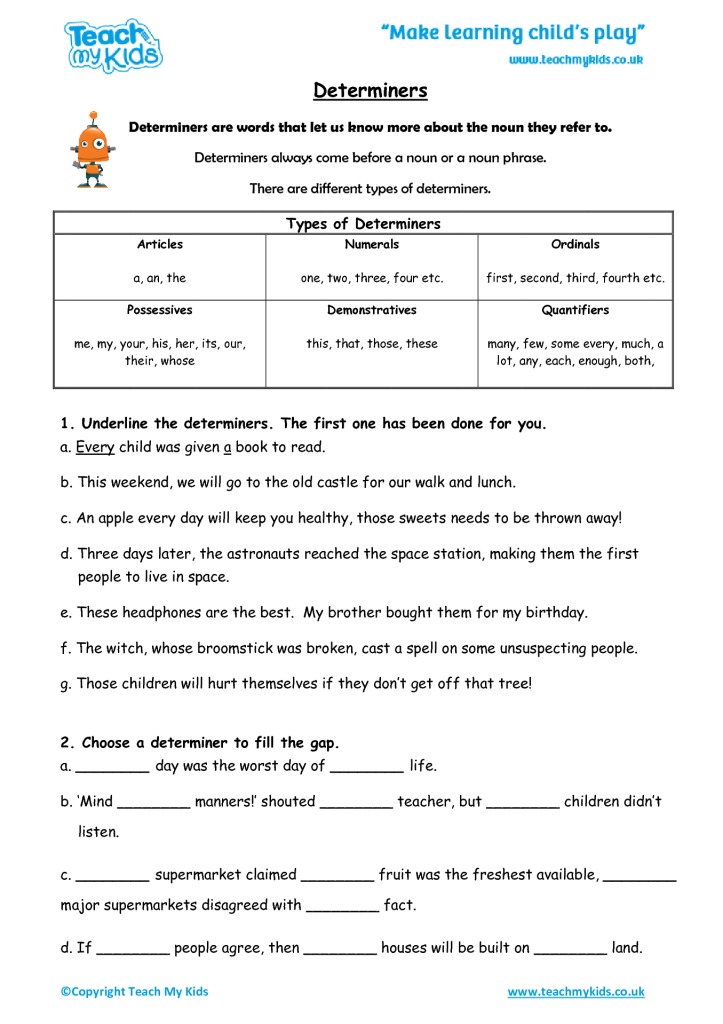
Without determiners, our language would be vague, ambiguous, and often grammatically incorrect. They are the linguistic pointers that guide our understanding of nouns in context.
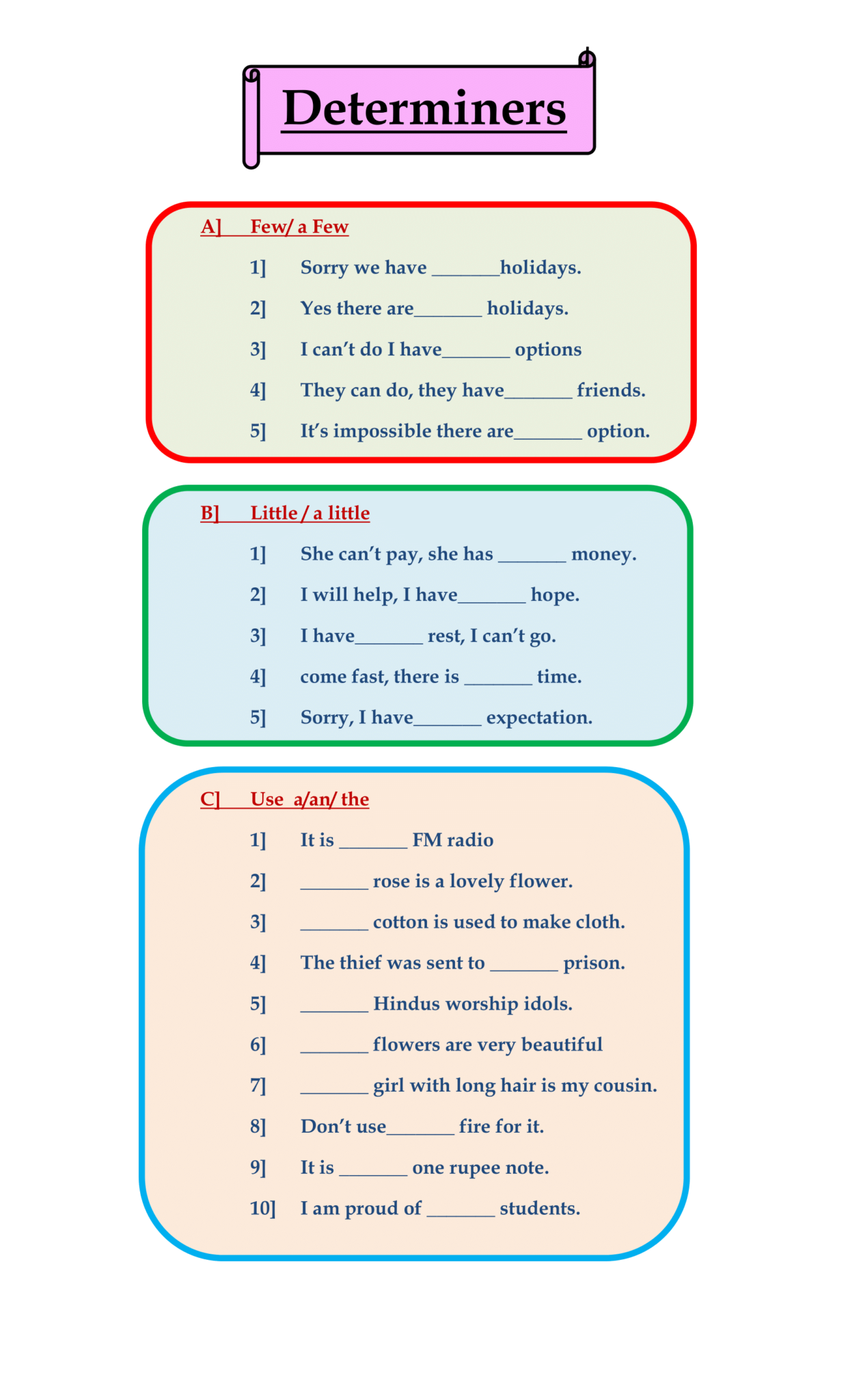
Why Are Determiners So Important?
The importance of determiners extends beyond mere grammatical correctness; they are fundamental to effective communication.
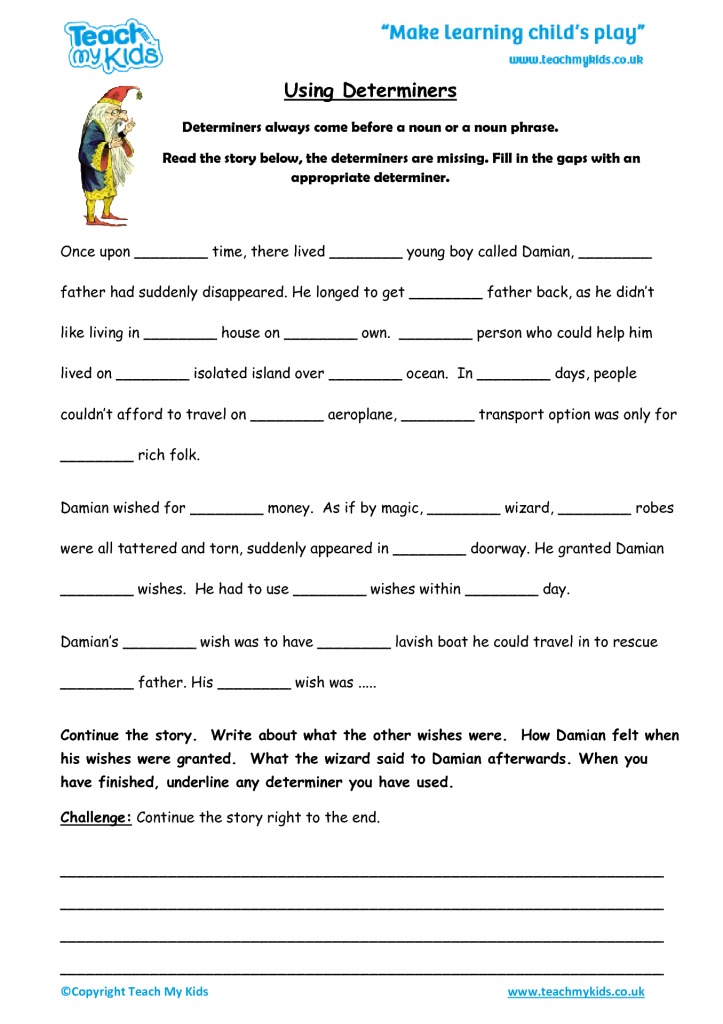
- Clarity and Specificity: Determiners eliminate ambiguity. "Bring me book" is incomplete and unclear. "Bring me the book," "Bring me a book," or "Bring me that book" provides precise instructions.
- Grammatical Accuracy: Many grammatical rules in English depend on the correct use of determiners, especially concerning singular/plural nouns and countable/uncountable nouns. Misusing them can lead to awkward sentences or even convey unintended meanings.
- Foundation for Advanced Grammar: A solid understanding of determiners is a prerequisite for mastering more complex sentence structures, such as relative clauses or noun phrases.
- Natural Language Flow: Native speakers intuitively use determiners correctly, making their speech and writing flow naturally. Learners need to develop this intuition, and consistent practice is key.

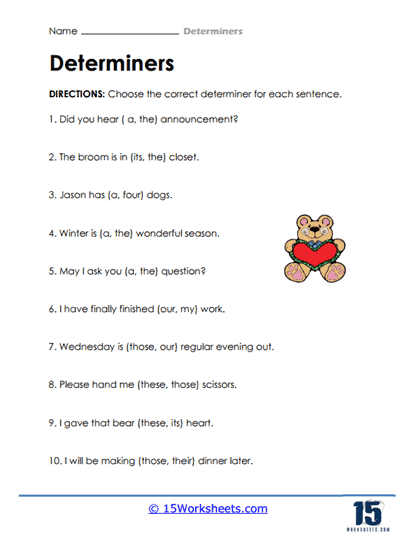
The Power of Determiners Worksheets
Given their critical role, how do learners effectively grasp the nuances of determiners? The answer lies in targeted, repetitive, and contextualized practice, which determiners worksheets are perfectly designed to provide. Worksheets bridge the gap between theoretical knowledge and practical application, allowing learners to actively engage with the concepts.
They transform passive learning (reading definitions) into active learning (applying rules). Through a variety of exercises, worksheets help reinforce understanding, identify areas of confusion, and build confidence in using these essential words correctly. They are not just busywork; they are structured learning tools that facilitate mastery.
Types of Determiners and How Worksheets Address Them
To create effective determiners worksheets, it’s crucial to understand the different categories of determiners and the specific challenges each presents:
-
Articles (a, an, the):
- Function: Indicate whether a noun is specific or general. "A" and "an" are indefinite articles (used with singular, countable nouns when general); "the" is the definite article (used with specific nouns, singular or plural, countable or uncountable).
- Worksheet Focus:
- A vs. An: Practice identifying vowel/consonant sounds (e.g., "an hour" vs. "a house").
- Definite vs. Indefinite: Exercises differentiating between general statements ("I want a cookie") and specific references ("I want the cookie you promised").
- No Article: Identifying instances where no article is needed (e.g., "I love music," not "I love the music" generally).
-
Demonstratives (this, that, these, those):
- Function: Point to specific nouns, indicating proximity (this/these for near, that/those for far) and number (this/that for singular, these/those for plural).
- Worksheet Focus:
- Proximity: Pictures or scenarios asking learners to choose between "this/that" or "these/those" based on distance.
- Number Agreement: Exercises requiring correct singular/plural matching (e.g., "this book" vs. "these books").
-
Possessives (my, your, his, her, its, our, their):
- Function: Show ownership or possession.
- Worksheet Focus:
- Matching: Matching pronouns to possessive determiners (e.g., "I" -> "my").
- Contextual Usage: Filling in blanks with the correct possessive based on the subject of the sentence.
- Its vs. It’s: Differentiating between the possessive determiner "its" and the contraction "it’s."
-
Quantifiers (some, any, much, many, little, few, a lot of, plenty of, several, all, no, etc.):
- Function: Indicate the amount or quantity of a noun. This is one of the most challenging categories due to countable/uncountable noun rules.
- Worksheet Focus:
- Countable vs. Uncountable: Exercises specifically targeting the use of "many/few" (countable) vs. "much/little" (uncountable).
- Some vs. Any: Practice using "some" in affirmative statements and offers/requests, and "any" in questions and negative statements.
- Contextual Choice: Scenarios requiring learners to choose the most appropriate quantifier (e.g., "I have plenty of time," "There are several options").
-
Numbers (one, two, first, second, etc.):
- Function: Specify exact quantities or order.
- Worksheet Focus: Simple fill-in-the-blank or sentence construction tasks.
-
Distributives (each, every, either, neither, both):
- Function: Refer to individual members within a group.
- Worksheet Focus:
- Singular Verb Agreement: Emphasizing that "each" and "every" usually take singular verbs.
- Either/Neither: Practice with choices between two options.
-
Interrogative Determiners (which, what, whose):
- Function: Used to ask questions about nouns.
- Worksheet Focus: Forming questions using these determiners.
Benefits of Using Determiners Worksheets
The systematic use of determiners worksheets offers numerous advantages for learners:
- Structured Practice: Worksheets provide a systematic and focused way to practice specific grammatical rules, ensuring all types of determiners are covered.
- Repetition and Reinforcement: Consistent practice through various exercises helps solidify understanding and embeds the rules into long-term memory.
- Contextual Learning: Most effective worksheets present determiners within meaningful sentences or short paragraphs, helping learners understand their function in real-world contexts.
- Error Identification and Correction: Learners can identify their common mistakes and work towards correcting them. Answer keys, if provided, allow for immediate feedback and self-correction.
- Variety of Exercise Types: Good worksheets offer a mix of multiple-choice, fill-in-the-blank, sentence completion, error correction, and even creative writing tasks, catering to different learning styles.
- Self-Paced Learning: Worksheets can be completed at a learner’s own pace, allowing them to spend more time on challenging areas.
- Assessment Tool: For educators, worksheets serve as an excellent formative assessment tool to gauge student comprehension and identify areas requiring further instruction.
Designing and Utilizing Effective Determiners Worksheets
Creating or choosing effective determiners worksheets requires thoughtful consideration:
- Gradual Difficulty: Start with basic identification and gradually move to more complex application, such as differentiating between similar determiners or using them in longer sentences.
- Clear Instructions: Ensure instructions are concise and easy to understand, even for learners who are struggling.
- Engaging Content: Use relatable scenarios, interesting facts, or short stories to make the exercises more appealing and less monotonous.
- Visual Aids: For demonstratives, incorporate images that clearly show proximity or number.
- Real-World Application: Include exercises that require learners to use determiners in questions, answers, or short descriptive paragraphs.
- Answer Keys: Providing an answer key empowers learners to check their work and understand their mistakes independently.
- Mix and Match: Don’t limit worksheets to just one type of determiner. Once individual types are understood, create mixed review worksheets that challenge learners to distinguish between them.
- Beyond Fill-in-the-Blanks: While fill-in-the-blanks are essential, incorporate activities like:
- Error Correction: Students identify and correct misused determiners in sentences.
- Sentence Transformation: Change sentences from general to specific, or singular to plural, requiring determiner adjustments.
- Descriptive Tasks: Ask students to describe a picture using various determiners.
- Role-Playing: Use scenarios where students must ask and answer questions using appropriate determiners (e.g., shopping, giving directions).
Common Challenges and How Worksheets Can Help
Learners often stumble upon specific areas when dealing with determiners:
- Countable vs. Uncountable Nouns: This is arguably the biggest hurdle. Worksheets specifically designed to categorize nouns and then apply the correct quantifiers (much/many, little/few, some/any) are invaluable.
- "A" vs. "An" vs. "The": Deciding which article to use (or not to use) requires a good grasp of context. Worksheets with varied scenarios can help differentiate.
- "This/That/These/Those" Agreement: Ensuring the demonstrative matches the number of the noun.
- Possessive Confusion: Mixing up possessive determiners with contractions (e.g., "its" vs. "it’s").
- Overuse or Underuse: Some learners might omit determiners entirely, while others might use them excessively. Worksheets help regulate this usage.
By repeatedly exposing learners to these specific challenges in a controlled environment, determiners worksheets build the necessary muscle memory and intuitive understanding.
Conclusion
Determiners, though small, are mighty pillars of English grammar, contributing significantly to clarity, precision, and natural communication. Their correct usage differentiates fluent speakers from those still grappling with the language. For educators and self-learners alike, determiners worksheets are an indispensable resource. They offer a structured, practical, and effective pathway to mastering these essential words, transforming abstract grammatical rules into tangible skills. Through consistent engagement with varied exercises, learners can overcome common pitfalls, build confidence, and ultimately achieve a higher level of fluency and accuracy in English. Investing time in targeted determiner practice is an investment in clearer, more effective communication.
